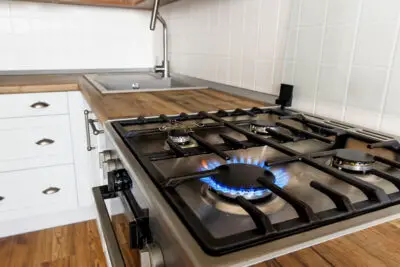Are you thinking about moving your stove to a new home or installing it in your kitchen for the first time? One important factor to consider is the weight of your stove. Knowing how much does stove weigh can help you plan for a smooth and safe move or installation.
The weight of a stove can vary widely depending on the size and type of stove. A small electric stove may weigh around 50 pounds, while a larger gas stove may weigh up to 300 pounds or more.
A wood-burning stove can also weigh several hundred pounds, depending on the materials used in its construction. It is always important to consider the weight of a stove before attempting to move it and to have adequate help and equipment when doing so to prevent injury or damage.
Importance of knowing the weight of a stove

You can never overlook the importance of knwoing the weight of a stove if you have to move from one place to another. There are several reasons why it is important to know the weight of a stove:
1. Safety
When moving a stove, it is important to have adequate help and equipment to prevent injury or damage. Knowing the weight of the stove will help you determine how many people you need to help you move it and whether you need to use a dolly or other equipment to support the weight.
2. Loading and unloading
If you are transporting a stove in a vehicle, you need to know the weight of the stove in order to properly load and unload it. This is especially important if you are using a trailer or other vehicle that has weight limitations.
3. Installation
The weight of a stove may also be a factor in determining where it can be installed and how it will be supported. For example, a heavy stove may require additional support or reinforcement on the floor or wall where it is being installed.
4. Energy efficiency
The weight of a stove can also be a factor in its energy efficiency. For example, a heavier stove may be more efficient at retaining heat, which can result in lower energy costs.
Generally, knowing the weight of a stove is important for a variety of reasons, including safety, transportation, installation, and energy efficiency.
How to choose the right size and weight of a stove for your needs
There are a few factors to consider when choosing the right size and weight of a stove for your needs:
Size of your cooking group: The size of the stove you need will depend on the size of your cooking group. For example, if you are cooking for a group of 4 or more people, you will likely need a larger stove.
Type of cooking you will be doing: If you plan on doing a lot of boiling, frying, or grilling, you will likely need a larger stove. On the other hand, if you will mostly be using the stove for simmering and boiling water, a smaller stove may be sufficient.
Available space: Consider the size and weight of the stove in relation to the available space in your camping area. A larger stove may be more difficult to carry, but it may also provide more cooking surface area and be more suitable for larger groups.
Fuel availability: Different stoves use different types of fuel, and the availability of fuel can influence your decision. For example, if you are camping in an area where liquid fuel is readily available, a liquid-fuel stove may be a good choice. However, if you will be camping in an area where fuel is scarce or unavailable, a stove that uses solid fuel such as wood or charcoal may be a better option.
Weight and portability: If you plan on carrying the stove with you on a backpacking trip, weight and portability will be important factors to consider. Lightweight, compact stoves are available, but they may have less cooking power and a smaller cooking surface area.
The impact of stove weight on its performance and efficiency

Stove weight can have an impact on its performance and efficiency in a few different ways.
First, heavier stoves tend to be more stable and less prone to tipping over, which can be important for safety and convenience. A heavier stove may also be less prone to vibrating or shaking when in use, which can be beneficial for cooking performance.
However, a heavy stove may also be more difficult to move and transport, which can be a drawback if you need to take your stove with you on camping trips or other outdoor activities. Additionally, a heavy stove may be more challenging to install, especially if you need to lift it onto a countertop or other elevated surface.
In terms of efficiency, the weight of a stove may not have a significant impact. However, the materials and construction of the stove can affect its efficiency. For example, a stove with thick, heavy-duty construction and insulation may be more efficient at retaining heat and reducing heat loss, which can lead to improved cooking performance and energy efficiency.
On the other hand, a lighter, less well-insulated stove may be less efficient at retaining heat and may require more energy to maintain the desired cooking temperature.
How to measure the weight of a stove for installation and moving
There are a few different ways to measure the weight of a stove for installation and to move:
Use a weighing scale: You can use a standard weighing scale to measure the weight of your stove. Simply place the scale on a flat, stable surface and place the stove on top of it. Make sure to position the stove evenly on the scale to get an accurate reading.
Check the manufacturer’s specifications: Many stove manufacturers will provide the weight of their products in the product specifications or on the product packaging. You can usually find this information in the owner’s manual or online.
Measure the weight using a lifting device: If you have a lifting device, such as a hoist or a forklift, you can use it to lift the stove and measure its weight. Make sure to follow all safety guidelines when using a lifting device.
Regardless of which method you use, it’s important to be aware of the weight of your stove so that you can plan for its installation and movement safely. If you are unsure about the weight of your stove or if you are not comfortable moving it on your own, it may be a good idea to seek the assistance of a professional.
Recommended:
The weight of different types of stoves (gas vs. electric)
The weight of different types of stoves, such as gas and electric, can vary significantly depending on the size, materials, and features of the specific model. Here are some general weight ranges for different types of stoves:
Gas stoves:
Gas stoves can range in weight from around 50 to 200 pounds, depending on the size and construction of the unit. Larger, professional-grade gas stoves may be heavier, while smaller, residential-grade stoves may be lighter.
Electric stoves:
Electric stoves can also range in weight from around 50 to 200 pounds, depending on the size and construction of the unit. Some electric stoves may be slightly lighter than comparable gas stoves due to the lack of heavy gas components.
It’s important to note that these are general ranges, and the actual weight of a specific stove may vary. It’s always a good idea to check the manufacturer’s specifications or weigh the stove using a scale or lifting device to get an accurate weight measurement.
The relationship between stove weight and its price
There is generally a positive relationship between stove weight and price, meaning that heavier stoves tend to be more expensive than lighter stoves. This is often due to the materials and construction of the stove. Heavier stoves may be made of thicker, more durable materials and may have more robust construction, which can make them more expensive to manufacture.
However, it’s important to note that there are many other factors that can influence the price of a stove, including the size, features, and brand of the stove. A heavier stove from a well-known brand with many advanced features may be more expensive than a lighter stove with fewer features from a lesser-known brand.
In general, it’s a good idea to consider the weight of a stove when making a purchasing decision, but it’s also important to consider other factors, such as the size, features, and overall quality of the stove, to ensure that you are getting the best value for your money.
Types of the stove and their weight

There are several types of stoves that are used for cooking and heating, and the weight of each type can vary significantly. Here is a list of some common types of stoves and their approximate weight ranges:
Gas stove: Gas stoves can range in weight from around 50 to 250 pounds, depending on the size and design.
Electric stove: Electric stoves can range in weight from around 100 to 250 pounds, depending on the size and design.
Wood stove: Wood stoves can range in weight from around 100 to 400 pounds, depending on the size and materials used.
Pellet stove: Pellet stoves can range in weight from around 100 to 300 pounds, depending on the size and design.
Propane stove: Propane stoves can range in weight from around 5 to 50 pounds, depending on the size and design.
Camp stove: Camp stoves are portable stoves that are designed for use in outdoor settings, and they can range in weight from around 1 to 10 pounds, depending on the size and design.
How to use stove weight as a guide for choosing the right model
Stove weight can be a useful factor to consider when choosing a stove model, especially if you plan to use the stove for backpacking or camping and will be carrying it with you. In general, lighter stoves tend to be more portable and easier to carry but may not be as stable or have as much cooking power as heavier stoves.
Here are a few things to consider when using stove weight as a guide for choosing the right model:
Consider the type of cooking you plan to do: If you just need a stove for boiling water or cooking simple meals, a lightweight stove may be sufficient. However, if you plan to do more elaborate cooking, you may want a stove with more power and heavier weight.
Think about the fuel type: Some stove fuels, such as white gas, are heavier than others, such as propane or isobutane. If you plan to use a fuel that is heavier, you may want to opt for a lighter stove to compensate.
Consider the size and weight of the stove: Lighter stoves tend to be smaller and more compact, making them easier to pack and carry. However, they may not have as much cooking power or be as stable as heavier stoves.
Take into account the overall weight of your gear: If you are trying to keep the weight of your gear to a minimum, a lighter stove may be a good choice. However, if weight is not a concern, you may be able to choose a heavier stove with more cooking power.
Conclusion
Knowing how much does a stove weigh will help in finding it easy to move from one place to another. On average, a standard 30-inch freestanding electric range with a smooth cooktop can weigh between 150 and 200 pounds, while a gas range of the same size can weigh between 200 and 250 pounds.
A built-in electric cooktop may weigh less than a freestanding range, while a built-in gas cooktop may weigh more. It is important to consider the weight of a stove when selecting one, as it can affect where you can install it and how difficult it will be to move.


